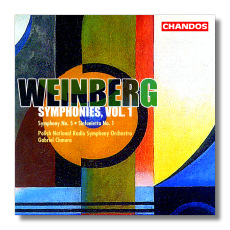
The Internet's Premier Classical Music Source
Related Links
- Latest Reviews
- More Reviews
-
By Composer
-
Collections
DVD & Blu-ray
Books
Concert Reviews
Articles/Interviews
Software
Audio
Search Amazon
Recommended Links
Site News
 CD Review
CD Review
Mieczysław Weinberg

- Symphony #5 in F minor, Op. 76
- Sinfonietta #1, Op. 41
National Polish Radio Symphony Orchestra, Katowice/Gabriel Chmura
Chandos CHAN10128 DDD 67:51
Mieczysław Weinberg lived between 1919 and 1996. He fled his Polish homeland in 1939, and came to the Soviet Union – first to Minsk, then to Tashkent, and finally to Moscow. He was befriended by Shostakovich, who was enthusiastic about his music, and who intervened when Weinberg was arrested in 1953 for being an "enemy of the people." Stylistically, Weinberg's music is often similar to Shostakovich's. Weinberg's Jewish heritage also takes a prominent role.
Weinberg's music is not uncommon on discs, but it has lacked the attention that it deserves from major labels and performers outside of the former Soviet Union. This new Chandos release, identified as "Volume 1," is a heartening sign that perhaps Weinberg's time has come.
These are two of his strongest and most immediately appealing works. The Fifth Symphony was written in 1962 for conductor Kirill Kondrashin (whose recording might still be available on Russian Disc RDCD11006). Apt comparisons have been made between this symphony and Shostakovich's Fourth, which, after years of suppression, was just seeing light of day again. Serious and elegiac, with moments of protest, this symphony is predominantly lyrical, and is an excellent introduction to Weinberg's fine symphonic oeuvre.
The First Sinfonietta dates from 1948, shortly after Shostakovich encouraged Weinberg to come to Moscow. Half the length of the symphony, it is more simply constructed and less emotionally complex. In this work, the Jewish elements are especially pronounced. The final movement, for example, is clearly based on klezmer music. Initially, the Sinfonietta's Jewish elements earned it praise from the commissars – this was music for the people – but it wouldn't be long before they were used against the composer, as anti-Semitism became more prominent in the Soviet Union.
Born in Poland and raised in Israel, Gabriel Chmura has an ideal background for Weinberg's music. He has been music director of the National Polish Radio Symphony in Katowice since 2001. This recording is further testimony to the extremely high quality of classical music performance in Poland; the Orchestra is world-class, and Chmura understands Weinberg's idiom perfectly. The engineering is similarly outstanding. I look forward to Volume 2.
Copyright © 2004, Raymond Tuttle


















